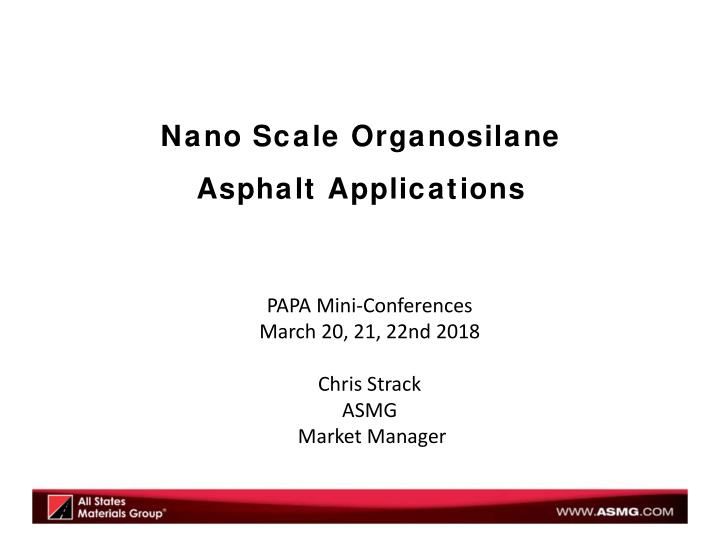



Nano Scale Organosilane Asphalt Applications PAPA Mini‐Conferences March 20, 21, 22nd 2018 Chris Strack ASMG Market Manager
Organosilane Chemistry • Developed over 50 years ago by Dow Corning for Epoxy/Fiberglass systems • Unique capability to form covalent bonds between inorganic and organic compounds. • Inherent stability and flexibility of the siloxane (Si‐O‐ Si) bond provides multiple benefits in bituminous applications.
Organosilane Chemistry By using the right organosilane, a poorly adhering coating can be converted to a material that will maintain adhesion even if subjected to severe environmental conditions (e.g., high temperature, underwater immersion or UV radiation). Source: Organosilane Technology in Coating Applications: Review and Perspectives, Thierry Materne, Global Silane Technology, et. Al. Dow Corning Corporation
Nano Scale Organosilane Chemistry • Nano Scale structures are under 100 nm Nanometer = 1 x 10 ‐9 meters • • Comparable Dimensions • Sheet of paper thickness = 100,000 nm • Human hair = 80,000 – 100,000 nm • 200 Sieve = 0.075 mm = 75,000 nm
Dual‐Reactive Organosilanes Bond Inorganic and Organic Substances Asphalt Mix Applications: • Nano Scale allows bonding to dust and fines • Complete coating of the entire aggregate surface Source: Organosilane Technology in Coating Applications: Review and Perspectives, Thierry Materne, Global Silane Technology, et. Al. Dow Corning Corporation
Organosilane Chemistry • Si forms four covalent bonds • Silicon Functional Groups bond to aggregate • Organofunctional groups bond to bitumen • Chemical bonding of the bitumen‐aggregate system decreases moisture susceptibility
Organosilane Effect on Asphalt Binder • Does not effect the Performance grade of the binder • No change to high temperature DSR values • No change in low temperature BBR values • Does not effect the Rotational Viscosity AASHTO T 316
Organosilane Function in Asphalt Mix • Aggregates are naturally hydrophylic due to polar surfaces created by SI‐OH‐ hydroxyl groups • Organofunctional alkoxysilane reacts at the aggregate– bitumen interface • Forms Si‐O‐Si bonds that are non‐polar – Aggregates repel water – Easily wetted by bitumen
Asphalt Binder Composition Asphalt microstructure is a three dimensional association of polar Asphaltenes (5‐ 15%), dispersed in non‐polar Maltenes (85 ‐95%) Asphaltene Image Sources: Dr. G.A. Mansoori
Organosilane Function in Bitumen • Organosilane molecules attracted to polar sites of asphaltenes • Micellize and isolate asphaltenes • May reduce viscosity of bitumen • Pen number decrease • Non‐toxic and odor‐less • Soluble with water/foaming systems
Organosilane Function in Asphalt Mixtures • Binds asphaltenes to aggregate surfaces • Allows easier movement of aggregate • Decreases asphaltene build‐up on plant • Acts as a compaction aid/WMA additive • Lowers mixing temp 10 ‐15 o C • Lowers compaction temp 35 ‐ 40 o C • Consistent compaction density over 90 – 100 o C range
PMA & CRMB using Organosilane • Can be used effectively as a compaction aid with PMA and Crumb rubber mix designs • Does not negatively effect the performance properties • May be added to binder before or after addition of polymer & rubber • May reduce apparent viscosities • Reduced stickiness with rubber • May reduce odor in rubber work
Multiple applications in asphalt materials • Asphalt Paving – antistrip / compaction aide • PMA modification aide • Crack sealants • Adhesives • Subgrade waterproofing
Organosilane Asphalt Binder Dose • 0.03% ‐ 0.10 % of asphalt binder weight for antistrip – Higher Silica materials = higher dose – Higher fines – higher dose – Higher asphaltenes – higher dose • 0.05% ‐ 0.10% of asphalt binder weight for warm mix / compaction aid – Higher asphaltenes – higher dose – Higher PMA – higher dose – Higher Silica – higher dose – Higher fines – higher dose
Life Cycle Extension Organosilane Nano Technology Enables • Improved oxidation resistance • Reduced water damage • Higher densities at lower compaction temperatures • Improved fatigue resistance • Improved bleed resistance
QUESTIONS? Chris Strack Marketing Manager Additives cstrack@asmg.com (203) 331‐2635
Recommend
More recommend